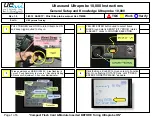
Chapter 9
Using LTE-TDD Signal Analyzer
302
JD700B Series User’s Guide
Select the bandwidth option from the choices:
1.4 MHz
,
3 MHz
,
5 MHz
,
10 MHz
,
15 MHz
,
and
20 MHz
.
3
To select the subframe number to be measured, complete the following steps:
Press the
Subframe No
soft key.
Enter a value by using the numeric keys. You can also use the rotary knob.
NOTE
For MBMS testing, this subframe number must be neither 0 nor 5 as these subframes 0
and 5 are not available for MBMS and it must be set to the MBMS transmitted channel’s
subframe number.
Press the
Enter
soft key.
4
Optional
. Toggle the
Physical Cell ID
soft key and select
Auto
or
Manual
as desired:
Auto:
Lets the instrument detect the Physical Cell ID for the LTE signal automatically.
Manual:
Sets a specific Physical Cell ID for the LTE signal manually in order to speed up
the synchronization with a BTS.
5
Optional
. Toggle the
CFI
soft key and select
Auto
or
Manual
as desired:
Auto:
Lets the instrument set the number of OFDM symbols used for transmitting PDCCHs
in a subframe.
Manual:
Sets the number of OFDM symbols manually. The set of OFDM symbols that can
be used for PDCCH in a subframe is given by
0
,
2
,
3
or
4
in 1.4 MHz bandwidth and
1
,
2
, or
3
in other bandwidths.
6
Optional
. Press the
PHICH Ng
soft key, and then select the option for the number of PHICH
groups (Ng):
1/6
,
1/2
,
1, 2
,
E-1/6
,
E-1/2
,
E-1
,
or
E-2
.
7
Press the
Uplink-Downlink Configuration
soft key, and then select the number of
uplink/downlink between one and six.
8
Optional
. Press the
Miscellaneous
soft key, and then do the following as needed:
To select the number of antenna ports, toggle the
MIMO
soft key and select
2x2
or
4x4
.
This MIMO (Multiple Input Multiple Output) setting is activated only if the option 031 LTE-
Advanced TDD is installed with a license number. If not, the instrument sets this option to
2x2 by default. A 2x1 or 4x1 RF combiner is also required to able to test on MIMO
channels.
To assign a antenna port number automatically or manually, press the
Antenna Port
soft
key and select the option:
Auto
,
0
,
1
,
2
, and
3
. If the option 031 LTE-Advanced TDD is not
installed or if the MIMO is set to 2x2, the antenna ports 2 and 3 are disabled.
To turn the Multimedia Broadcast Multicast Service (MBMS) feature on or off, toggle the
MBMS
soft key and select
On
or
Off
. For proper MBMS testing, you need to set the
Subframe No
with the same PMCH subframe number. If this setting is on, either PMCH or
PDSCH appears on the screen depending on the detected channel.
To set the Multicast Broadcast Single Frequency Network (MBSFN) detection automatically
or manually for MBMS testing, toggle the
MBSFN
soft key and select
Auto
or
Manual
. An
automatically detected or manually entered MBSFN ID appears on the screen.
To set the delay, complete the following steps:
Press the
Delay
soft key to set the amount of delay in µs.
Enter a value by using the numeric keys. You can also use the rotary knob.
Press the
µs
soft key.
NOTE
The Delay setting is used only when there is a time offset in the signals to be measured.
To select the cyclic prefix, toggle the
Cyclic Prefix
soft key and select
Normal
or
Extended
. See “Appendix E – Cyclic prefix table” on page 784 for OFDM parameter details
by different bandwidth.
Press the
PDSCH Modulation Type
soft key, and then select the modulation type option:
Auto
,
QPSK
,
16 QAM
,
64 QAM
,
E-TM3.3
,
E-TM3.2
,
E-TM3.1
,
E-TM2
,
E-TM1.2
, and
E-TM1.1
. If two or more modulation types are used in a frame, select
Auto
. If the PDSCH
uses the same modulation type in a frame or in a subframe, select a specific modulation
type to get more accurate EVM.
















































